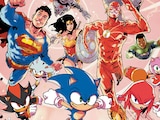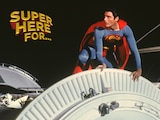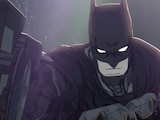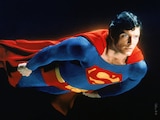For those of you unfamiliar, the Earth One graphic novels are special out-of-continuity stories that reimagine some of the DC Universe's most familiar heroes in a totally unfamiliar light, whether it's stripping Green Lantern of his willpower or imagining Bruce Wayne getting kidnapped for ransom rather than orphaned in an alleyway.
For Diana Prince, Earth One means a brand-new look at both the origin story of Wonder Woman, the culture of Themyscira altogether and her role as an Amazon ambassador to the world of man, something that gets further explored under the highest of stakes in the upcoming, eagerly anticipated WONDER WOMAN: EARTH ONE VOL. 2. Recently, we sat down with writer Grant Morrison and artist Yanick Paquette to get some insight on their world building process, their vision of Diana, and most importantly, some exclusive teases for what’s ahead in volume two.

So, when we left Wonder Woman: Earth One, it was with a pretty major cliffhanger. Diana wants to have a chat. What is that conversation going to sound like?
Grant Morrison: We wanted to make a version of the Wonder Woman story that was almost plausible or almost believably real. So, WONDER WOMAN: EARTH ONE VOL. 1 was the idea of, you know, what happens if a beautiful princess comes up from a previously unknown island that has better technology, better ideas, more amazing philosophies—better everything. They're so much better than our culture. How does man's world react to that? The patriarchy of the world outside of Paradise Island, how does that culture react?
With the second volume, it's our Empire Strikes Back volume. It's Diana coming up against the lens of her beliefs and she sees this big challenge from the world as we know it. It's kind of very much what would happen to Wonder Woman in the actual real world.
In a story that revolves so much around folding in the sort of disparate elements of Diana's history and giving them an update or a bit of a rework, has there been anything either of you have been really excited to get your hands on?
Morrison: Yeah! I'll let Yanick talk next here, but for me it was definitely going back to the William Marston stuff and it was really about those weird ideas that he had. He was a very interesting man, led a very interesting life, and his ideas were quite strange. We want to take those ideas as the root of Wonder Woman very seriously, and also critique them. I think for me that was the interesting thing, going back to those strange, psychological 1930s bondage polyamory ideas and saying, "What would happen? What would actually happen if those were exposed to the way people think now?"
So for me, it was taking the original source of Wonder Woman and being really serious about it. Treat it as something new, but also kind of question it, expose it. At the same time, consider it like something to offer.
Yanick Paquette: These characters have been reworked over generations and though I really enjoy the Wonder Woman as she's mainstreamed today—which is closer the classical superhero, fighting, etc.—the early Wonder Woman is so strange and so original, it's almost sad that it's being...not forgotten, but somehow made incompatible now. So, we are trying to find a way to make that relevant again, and that challenge I think is worth exploring. It's the original version, so.

Yanick, in the first volume, the Amazons—even the ones who go totally unnamed in the story—have really distinct looks and costumes. Can you talk a little about populating this world and where you pulled from to flesh it all out even beyond the core cast? Where are those designs coming from?
Paquette: I love research, so when I do a project with a real place, I spend a lot of time in Google "walking" the streets or just gathering a massive amount of imagery. But with something that's fantasy, I felt like I needed something that I could use as a basic ingredient that I could extrapolate to really show their culture. So, in the case of the island, their clothing, their technology, I wanted to take some flare from the original Greek aspect of them, but I thought about how it would be if it was exposed to nature, to birds, sea shells, feminine forms. So, these are the basic ingredients from which I can try to extrapolate what this culture would look like. For everything—for a building, for a door knob, for a weapon—I looked at them and thought, "Oh yeah, have seen these things for years." So, it makes sense.
But I also wanted them to seem indebted to the Greek side of their culture without feeling trapped by it, which I feel sometimes people do.
Morrison: I feel like that's also where we're different from the movie version, which I really loved, but what we're doing is saying that in this research and years of mythology, the Amazons have developed their own philosophy, their own way of speaking, their own way of living. That's the ideal and also the threat they represent: they have an alternative culture.
You're still working with colorist Nathan Fairbairn on the second volume, yes? Or is it a different colorist coming in?
Paquette: Oh yeah, I'm a very faithful guy. Nathan's my man. We've been sharing a secret cloud hard drive that DC doesn't see so we can solve our graphic problems and work through whatever we don't agree on. Part of the idea that Nathan and I had with these books was this bright—not bright as in punchy color, but sometimes these narratives can get very dark and dramatic in the colors. So, we felt like we wanted to see the beauty and the poetry. I wanted to see the sun and the warmth of the island. I think we're going in that direction for volume two, too.

Is the second volume predominantly going to be set on Man's World, or will we be hopping back and forth between that and the island again?
Morrison: We cut back and forth. It's not quite as cut-and-dry as volume one, but there's certainly a back and forth. But it's mostly about Diana in Man's World and how Man's World reacts.
Though I'll always put "Man's World" in scare quotes. It's hard to deal with a strange culture, especially coming from an even stranger culture that's even more evolved. It's about Diana's interaction with that world, and I think that's what we've done. We've separated her friends and family. She can't go back home for reasons you'll see in the book, and she's up against forces she's never imaged. She's a very progressive, forward-looking young woman, and suddenly she's up against very understandable modern forces of inertia.
In volume one, we've got the Gorgon a little bit, we've got Hercules who has kind of been re-cast from his—I won't say "traditional" story, but we see him in a form we haven't seen in a while…
Morrison: Hercules is somehow involved with Diana's parentage with Hippolyta. I love the character Hippolyta. I love the idea that she basically just took Hercules' genetic material and decided to weaponize it for women. She took the ultimate monster, the ultimate masculine force, and turned it into a weapon for women. It's not so much that Hercules is Diana's father in this story, it's that Hippolyta used Hercules' genetic material to create Diana.

New art from Wonder Woman: Earth One Vol. 2
Are we going to see any other, I don't want to say pure "villains" since that might not be the best term for this particular universe, but are we going to see any villain-style characters showing up?
Morrison: Yes, absolutely! Volume two is all about Diana's confrontation with Doctor Psycho. He's one of the old school villains that Marston created, and he was this hypnotic monster and our version of Doctor Psycho is visually quite similar, but we based him on "pick-up artists" and this whole idea of toxic masculinity. We're approaching ideas that are very current in culture lately, so our Doctor Psycho is a hypnotist of a very different kind. He still harks back to the original, but—
Paquette: Yeah, he does! But he kind of looks almost like a lion now, the hair and everything. From the point-of-view of finding a villain who would challenge Wonder Woman now where she is in her evolution, Doctor Psycho is perfect. It's not a physical confrontation. There's no fighting. She doesn't see it coming. She doesn't suspect a person who is trying to bend her will to his own purpose. I think he's the perfect villain for this place.
I was trying to create a correlation for that in the panel borders. There's a fight going on between the feminine, more elegant art nouveau and the Doctor Psycho stuff which is more art deco, more angular. People might not pick that up, but… .
Something that really makes volume one stand out is how unique the page layouts are. When you were putting the book together, what influenced those choices?
Paquette: Part of what I try to do these days is really take advantage of the fact we're doing comics and not, like, movies or anything. So, one thing we have is those panel borders, which can add an extra layer to the story. You always need to tell the story. In the first volume, I used the old Greek poetry for the conflict of Hercules and Hippolyta—
Morrison: And also—sorry to interrupt—the idea of the rope and the gold twine that the fates weave. It runs through the entire last volume.
Paquette: So, there's definitely a way to use those panel borders as a narrative engine. I push it a little further in the second volume as well, as we have panels for Psycho, for Diana, but also when we use the lasso.

New art from Wonder Woman: Earth One Vol. 2
To wrap up, I'm going ask you a pretty challenging question, and I apologize if this is too much for something so on the spot. Diana's pretty unique in the DC Universe, even among the trinity, because she doesn't necessarily have a one or two-phrase mission statement or way to summarize her whole identity. She's not vengeance or the night, she's not really truth, justice and the American way. What do you think the central tenet of Wonder Woman is? What's most important for her to display on Earth One?
Morrison: Oh wow… I think—and I know this is more than just a couple of sentences—we want to play Diana as the ambassador for something really quite new. An entirely new way of civilization. A new way of philosophy and culture and poetry and love…and that's what she is. She's a progressive, weird figure, and I love to extend that to full-on science fiction. What if the Amazons took over the planet, you know?
Paquette: The way we've been playing it, playing her, is that she's sort of a bridge between the current patriarchal world and where we might go. It's an equilibrium. Our Amazons are not perfect, they're flawed—
Morrison: And so are we, eh?
Paquette: And Wonder Woman might bring those two extremes together.
Morrison: Yeah, as Yanick says, Diana is that bridge. She's the connection between us and the world of the Amazons, which really can be quite weird and separatist and elitist, but it's also beautiful and utopian.
WONDER WOMAN: EARTH ONE VOL. 2 by Grant Morrison, Yanick Paquette and Nathan Fairbairn will be available in print and digital this August.




















